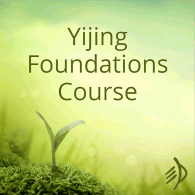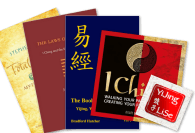There’s a well-established tradition that these trigrams portray fast-moving fire burning through mountain vegetation.
Kong Yingda (574-648AD) wrote,
‘When fire is on top of the mountain, it races through the grass and shrubbery, a condition that does not leave it in one place for long. Thus this provides the image for the Wanderer.’
R.J. Lynn, I Ching
There could be other pictures too, though. Long before I learned the traditional view from Wilhelm, I imagined that the noble one of the Image –
‘Above the mountain is fire: Travelling.
Hexagram 56, the Image
A noble one is clear and thoughtful in administering punishments, and doesn’t draw out legal proceedings.’
– was only stopping overnight, and needed to resolve all disputes before the ashes of the campfire were scattered in the morning. And you can also simply picture the way sunlight and clouds, light and shade, move ceaselessly over a mountain landscape.
However you picture this one, you can see it means movement. (Contrast how the lake gathers on the mountain-top in Hexagram 31.) And it’s always worth imagining the trigram picture for yourself, as if you were the first person ever to see the hexagram.
‘Travelling, creating small success.
Hexagram 56, the Oracle
Travelling, constancy brings good fortune.’
If you have clear vision of the place where you’ve stopped to rest (as the Tuanzhuan says), you can enjoy some small success – though nothing too great, as you don’t live here; you’re not going to transform the place, but at least you won’t break its rules.
With ‘travelling, constancy brings good fortune,’ I wonder whether this might not be ‘traveller-constancy’, a particular kind of constancy, like the mare’s constancy in Hexagram 2. A traveller’s constancy would mean holding fast not to where you are or the people around you – ‘few connections for the Traveller’, says the Zagua – but to where you’re going and who you want to be on the way. That’s all you have: a traveller has no insulating reputation or connections to remind him of himself.
So you need a blend of firm steadfastness and clear insight – which sounds very much the trigrams: inner gen as steady sense of identity, outer li as awareness. Know who you are, see where you are, and you should be able to keep moving with the minimum of nest-burning.
‘Above the mountain is fire: Travelling.
A noble one is clear and thoughtful in administering punishments, and doesn’t draw out legal proceedings.’
The word I’ve translated as ‘draw out’ actually means ‘stay, remain, tarry’ – so perhaps we should say the noble one doesn’t dwell on legal proceedings. The basic advice is plain: move on. Sort things out before the ashes cool; take the consequences as necessary, but don’t set up home in the dispute.
The inner mountain means, as Wang Bi says, that ‘he pauses to gain clarity over things’: the inner trigram gives rise to the outer. The inner mountain might also encourage thoughtfulness: it’s inwardly stable, not impulsive or reactive. And the mountain marks a place to stop. This issue is done with, the line is drawn, and we move on.
Look how different this is from the Image of Hexagram 22, where the same two trigrams swap places:
‘Below the mountain is fire. Beauty.
Hexagram 22, the Image
A noble one brings light to the many standards, but does not venture to pass judgement.’
When light’s on the inside, contained by the mountain, it stops and thinks, and experiences inward insight or realisation, but passes no judgement at all. The traveller sees from the outside: the light is moving on, not contained, while rock-solid standards, already known and internalised, can be made visible in punishments.









